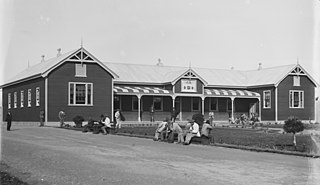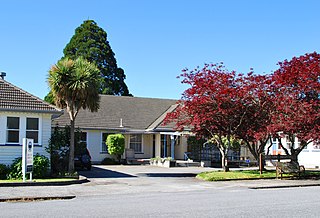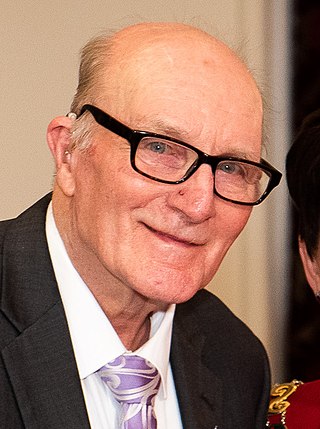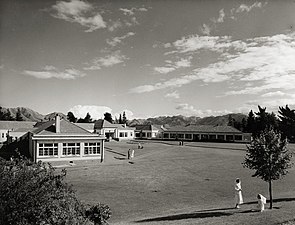
The Royal London Hospital is a large teaching hospital in Whitechapel in the London Borough of Tower Hamlets. It is part of Barts Health NHS Trust. It provides district general hospital services for the City of London and Tower Hamlets and specialist tertiary care services for patients from across London and elsewhere. The current hospital building has 845 beds, 110 wards and 26 operating theatres, and opened in February 2012.

Hanmer Springs is a small town in the Canterbury region of the South Island of New Zealand. The Māori name for Hanmer Springs is Te Whakatakanga o te Ngārahu o te ahi a Tamatea, which means “where the ashes of Tamate’s (sic) fire lay”, referring to Tamatea, the captain of the canoe Tākitimu.

The Maudsley Hospital is a British psychiatric hospital in south London. The Maudsley is the largest mental health training institution in the UK. It is part of South London and Maudsley NHS Foundation Trust, and works in partnership with the Institute of Psychiatry, King's College London. The hospital was one of the originating institutions in producing the Maudsley Prescribing Guidelines. It is part of the King's Health Partners academic health science centre and the National Institute for Health and Care Research (NIHR) Biomedical Research Centre for Mental Health.

The Royal National Orthopaedic Hospital (RNOH) is a specialist orthopaedic hospital located in the London Borough of Harrow, United Kingdom, and a part of Royal National Orthopaedic Hospital NHS Trust. It provides the most comprehensive range of neuro-musculoskeletal health care in the UK, including acute spinal injury, complex bone tumour treatment, orthopaedic medicine and specialist rehabilitation for chronic back pain. The RNOH is a major teaching centre and around 20% of orthopaedic surgeons in the UK receive training there.

The Royal Victoria Hospital commonly known as "the Royal", the "RVH" or "the Royal Belfast", is a hospital in Belfast, Northern Ireland. It is managed by the Belfast Health and Social Care Trust. The hospital has a Regional Virus Centre, which is one of the four laboratories in the United Kingdom on the WHO list of laboratories able to perform PCR for rapid diagnosis of influenza A (H1N1) virus infection in humans.

Matron is the job title of a very senior or the chief nurse in several countries, including the United Kingdom, and other Commonwealth countries and former colonies.

University Hospital Hairmyres is a district general hospital in the Hairmyres neighbourhood of East Kilbride, South Lanarkshire, Scotland. The hospital serves one of the largest elderly populations in Scotland. It is managed by NHS Lanarkshire.

Wellington Hospital, also known as Wellington Regional Hospital, is the main hospital in Wellington, New Zealand, located south of the city centre in the suburb of Newtown. It is the main hospital run by Capital & Coast District Health Board (C&CDHB), which serves Wellington City, Porirua and the Kapiti Coast District.

Auckland City Hospital is a public hospital located in Grafton, Auckland, New Zealand. It is the largest hospital in New Zealand, as well as one of the oldest medical facilities in the country. It provides a total of 1,165 beds. It was established in 2003 as an amalgam of Auckland Hospital, Starship Hospital, Green Lane Hospital and National Women's Hospital. Public hospitals in Auckland have been run by Te Whatu Ora – Health New Zealand since 2022.

The Seaview Asylum was a psychiatric hospital located to the north of Hokitika, in the West Coast Region of New Zealand's South Island, adjacent to the former Westland Hospital. Open from 1872 to 2009, Seaview trained psychiatric nurses and was once the town's biggest employer.
Mabel Thurston was a notable New Zealand nurse, hospital matron and army nursing administrator.
Alice Hannah Holford was a New Zealand nurse, midwife and hospital matron.

King Edward VII's Hospital is a private hospital located on Beaumont Street in the Marylebone district of central London.
Whakatāne Hospital is a hospital in New Zealand, serving the town of Whakatāne, and the Eastern Bay of Plenty. It is operated and managed by the Bay of Plenty District Health Board.
Mary Francis Looney was a New Zealand civilian and wartime nurse. She served in World War I and was made an Associate of the Royal Red Cross.
Christina McDonald was a New Zealand nurse. She served with the Royal New Zealand Navy in World War II and was Director of Nursing Services for the New Zealand Army, Navy and Air Force from 1958 to 1964.
Victoria Jubilee Hospital was founded in 1891 and opened to the public in 1892 in Kingston, Jamaica. The current facility, the largest maternity hospital in the English-speaking Caribbean, features 248 beds and delivers around 8,000 babies annually.
The 2019 Queen's Birthday Honours in New Zealand, celebrating the official birthday of Queen Elizabeth II, were appointments made by the Queen in her right as Queen of New Zealand, on the advice of the New Zealand government, to various orders and honours to reward and highlight good works by New Zealanders. They were announced on 3 June 2019.

Reefton Hospital is a hospital in Reefton on the West Coast of New Zealand. It was founded in 1872 and remains in operation.

Robert John Mackay Crawford was a British-born New Zealand doctor who specialised in the treatment of alcoholism and addictions. He was medical superintendent of Queen Mary Hospital in Hanmer Springs from 1976 to 1991 and an advocate for residential treatment for addictions.
































